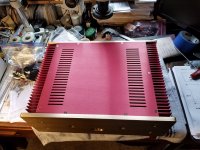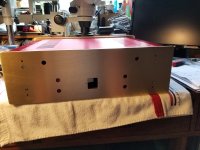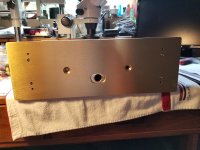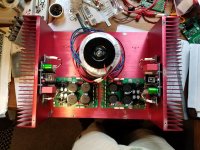I was always fascinated with X's measurements using carbon resistors v. metal film resistors in the feedback networks of the Alpha. He demonstrated conclusively that metal films bring up the third harmonic over the second; the carbons do the opposite.
Best sounding amps have a monotonic decrease of successive harmonics, and the more linear, the better. This is from Jean Hiraga in the 60s - nothing is new and demonstrates how the marketing speak drives the equation rather than the truth.
Cheers,
Hugh
So am I right, Hugh, in concluding that the carbon composition resistors were put there for a purpose - so the result was a monotonically decreasing harmonic profile?
If so - that's great, in my view. 🙂 But it implies that you will change the 'sound' of the amp if you use metal films instead! 🙁
Which is not a good thing, I would suggest.
Andy
Amplifier design and speaker interaction is complex topic i do no pretend to understand. Low output impedance or high? What damping? Current drive?
Speaker impedance? Low? High? Which is better? Flat impedance? Phase?
All complex issues.
Luckily things are not that desperate. I simply know if i like the sound within few minutes. It does not need much. Sound is easy pleasing me or not. I may not be able to explain why i like certain sound, but there are two criteria amp has to have.
Great hights and imaging.
Its the amp has sharp itchy high frequencies, i do not like it. Although i do not like mushy wooly hights. Hights must be as crystal clear as possible.
Second, imaging, has lot to do how much or little my brain has to work to follow individual instruments or voices. If its easy, image is great. If its all fused together in big mess, image has collapsed. With good imaging, sound is in the air, almost separated from the speakers. If i hear sound shouting from speakers, image is gone.
Does this makes sense?
How does one measure all this?
Speaker impedance? Low? High? Which is better? Flat impedance? Phase?
All complex issues.
Luckily things are not that desperate. I simply know if i like the sound within few minutes. It does not need much. Sound is easy pleasing me or not. I may not be able to explain why i like certain sound, but there are two criteria amp has to have.
Great hights and imaging.
Its the amp has sharp itchy high frequencies, i do not like it. Although i do not like mushy wooly hights. Hights must be as crystal clear as possible.
Second, imaging, has lot to do how much or little my brain has to work to follow individual instruments or voices. If its easy, image is great. If its all fused together in big mess, image has collapsed. With good imaging, sound is in the air, almost separated from the speakers. If i hear sound shouting from speakers, image is gone.
Does this makes sense?
How does one measure all this?
Does this makes sense?
Absoloootely! 🙂
How does one measure all this?
One can't! 😀
Andy
Adason,
I don't think your criteria are measureable yet. The technology has not caught up with the subjective observations. But there is information which will give you a good idea of the sound quality, and the measuring gear can be had for low cost now.
OTOH, subjective observations seem to vary from person to person. It is a bit like food, or clothing. It is not realistic to be objective about the subjective, so it's necessary to have a listen for yourself to be sure that what you like is also liked by the reviewer. This puts you at the mercy of the reviewer, and you never really know his agenda and his preferences.
Given the difficulty of assessing something from another continent, you are forced to read as many reviewers you can and then take an average over a number. Or, talk to existing owners, like JYG is doing.
I do hope that in the 21st century people start to consider the harmonic profile of amps, not just the lumped parameter, THD. The profile tells you a lot more than THD.
Cheers,
Hugh
I don't think your criteria are measureable yet. The technology has not caught up with the subjective observations. But there is information which will give you a good idea of the sound quality, and the measuring gear can be had for low cost now.
OTOH, subjective observations seem to vary from person to person. It is a bit like food, or clothing. It is not realistic to be objective about the subjective, so it's necessary to have a listen for yourself to be sure that what you like is also liked by the reviewer. This puts you at the mercy of the reviewer, and you never really know his agenda and his preferences.
Given the difficulty of assessing something from another continent, you are forced to read as many reviewers you can and then take an average over a number. Or, talk to existing owners, like JYG is doing.
I do hope that in the 21st century people start to consider the harmonic profile of amps, not just the lumped parameter, THD. The profile tells you a lot more than THD.
Cheers,
Hugh
X, could you please post the promised correction/clarifications on #1 in the thread and rule out further misunderstandings? Lot has been said but lacks precision. R124, 126, R133, R135?
Sorry folks, did I mis the definitive info
Hi Francois G,
Regarding R124, R126, R133, R135
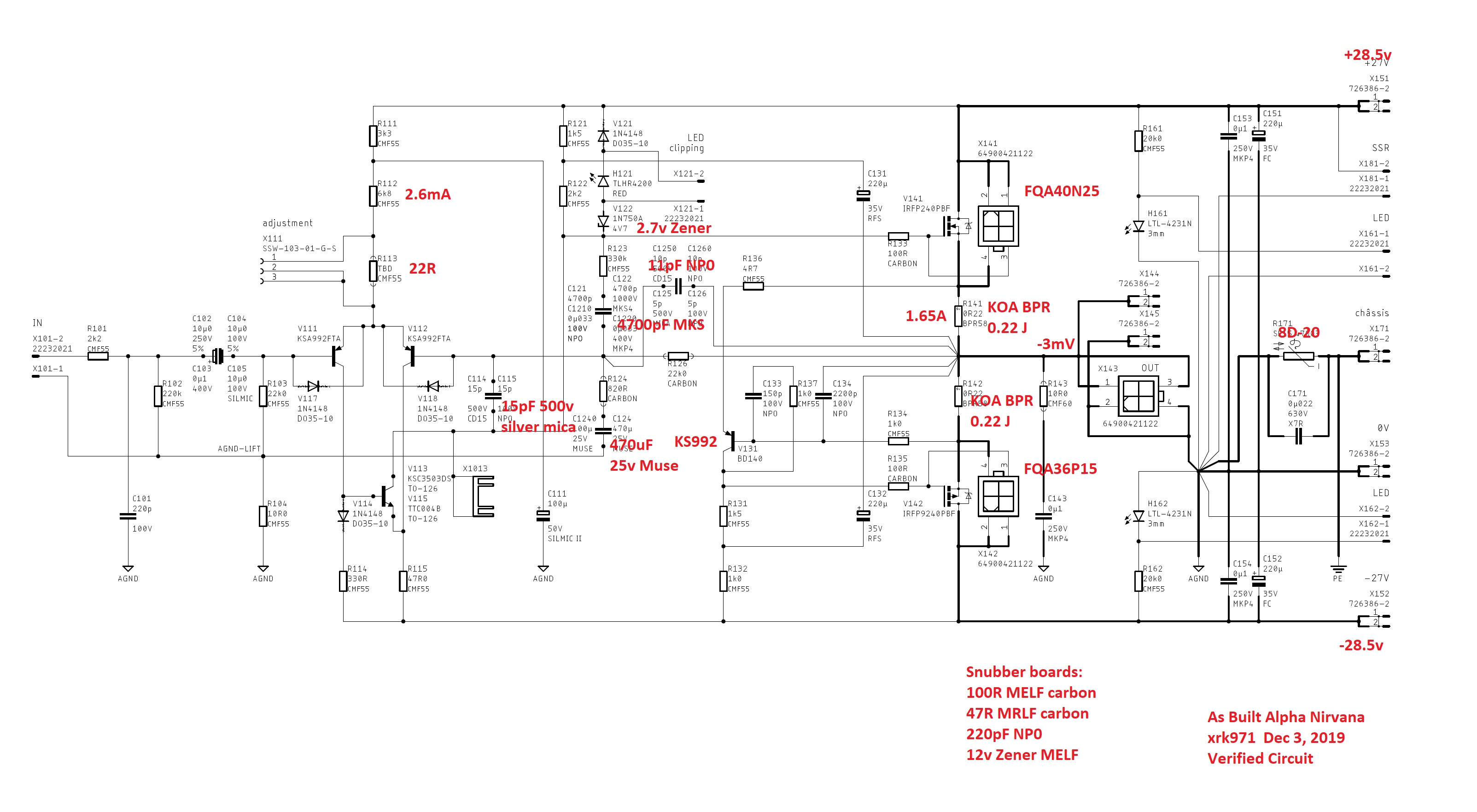
Here is my opinion:
If you use high quality 1% metal thin film on all of these, your amp will sound fine and dandy.
If you believe that having a slightly better redistribution of higher 2nd order harmonic distortion vs third order is something you want (we are talking maybe 2-3dB difference), then change R126 to carbon film. But not carbon composition. They don't come better than 5% so you need to hand match them to get balanced left and right channels. R124 is not as critical and leave as metal thin film is ok. More power is disspated across the R124 feedback resistor.
Do not use metal oxide thick film under any circumstance for R126. It will increase third harmonic and overall higher THD.
For the gate snubbers, I am not sure what to say other than either metal thin film or carbon thin film works well. I have used even metal oxide thick film here without problem. The current to gate is so small it doesn't matter I think.
I have heard that carbon composition is not stable and may generate more distortion, however, have not verified it myself. I do know that they are very good at absorbing high pulse energies so great for pulsed snubbers.
Regarding R124, R126, R133, R135
Here is my opinion:
If you use high quality 1% metal thin film on all of these, your amp will sound fine and dandy.
If you believe that having a slightly better redistribution of higher 2nd order harmonic distortion vs third order is something you want (we are talking maybe 2-3dB difference), then change R126 to carbon film. But not carbon composition. They don't come better than 5% so you need to hand match them to get balanced left and right channels. R124 is not as critical and leave as metal thin film is ok. More power is disspated across the R124 feedback resistor.
Do not use metal oxide thick film under any circumstance for R126. It will increase third harmonic and overall higher THD.
For the gate snubbers, I am not sure what to say other than either metal thin film or carbon thin film works well. I have used even metal oxide thick film here without problem. The current to gate is so small it doesn't matter I think.
I have heard that carbon composition is not stable and may generate more distortion, however, have not verified it myself. I do know that they are very good at absorbing high pulse energies so great for pulsed snubbers.
Last edited:
X, thanks very much for clarifying the resistors in question. Since I have bought the parts, but have not soldered them yet, I have the opportunity to do it right the first time.
I am posting the progress that jhofland is making on a commissioned amp for a member on DIYA with the usual dual SLB's and dual trafos for the PSU. The chassis is a particularly colorful one from Aliexpress. Jhofland will design a custom soft start with a remote on/off switch for this amp. It will also use the RTR SSR speaker protection modules.

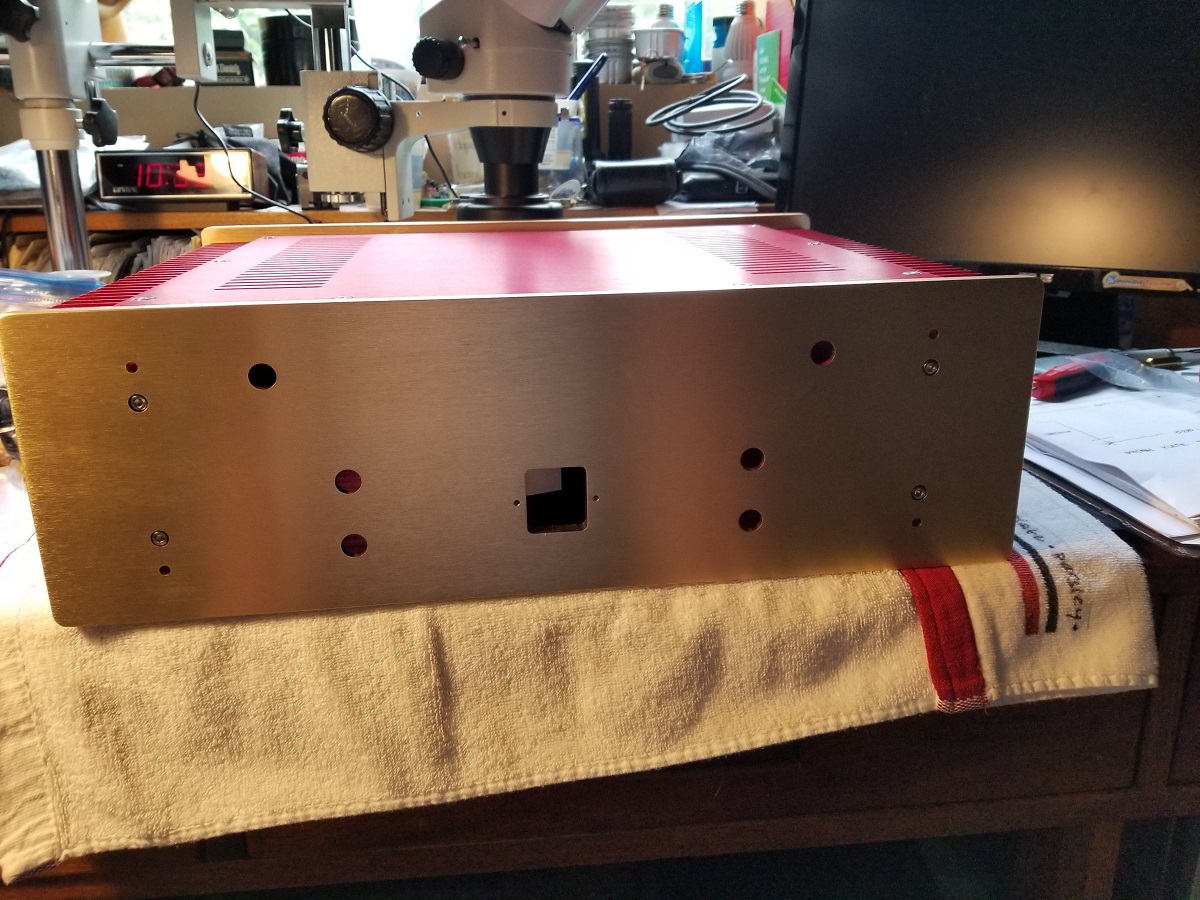
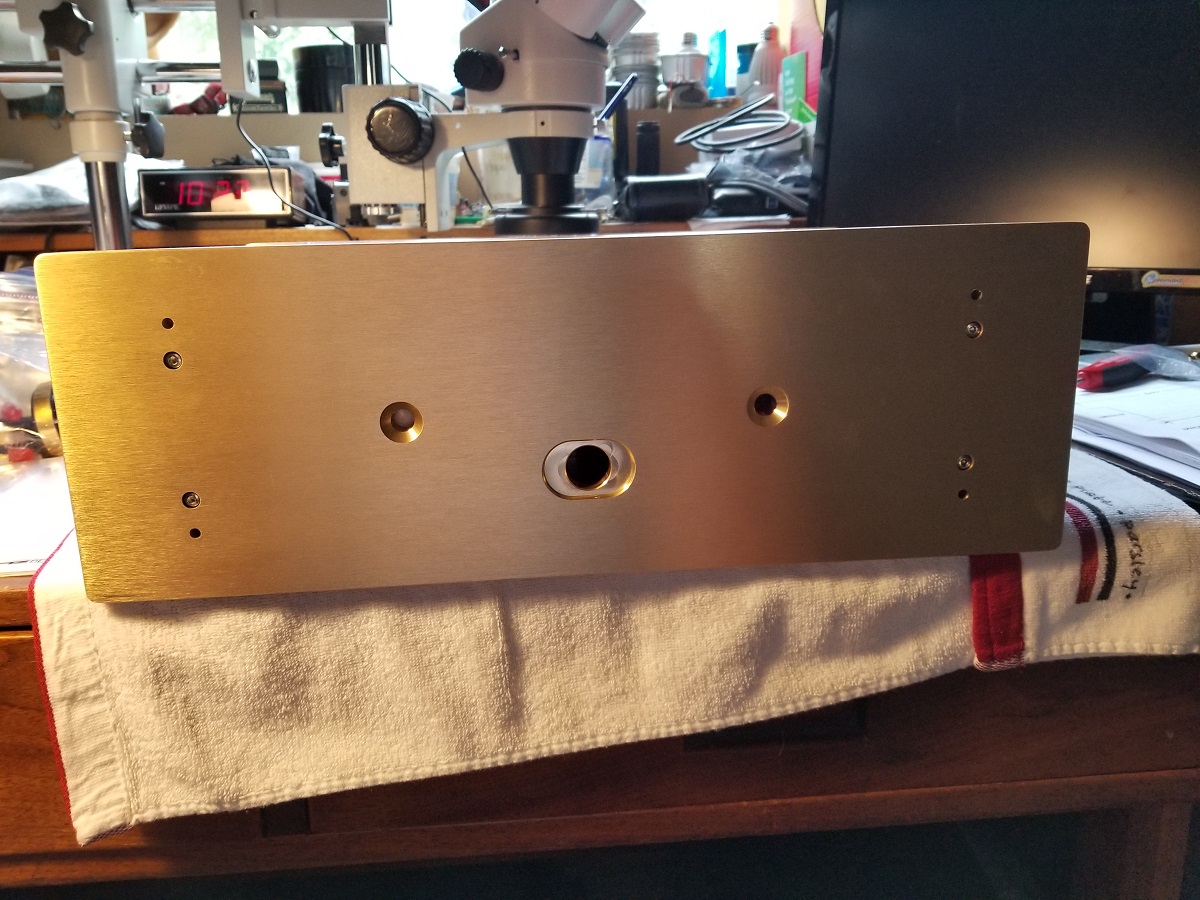
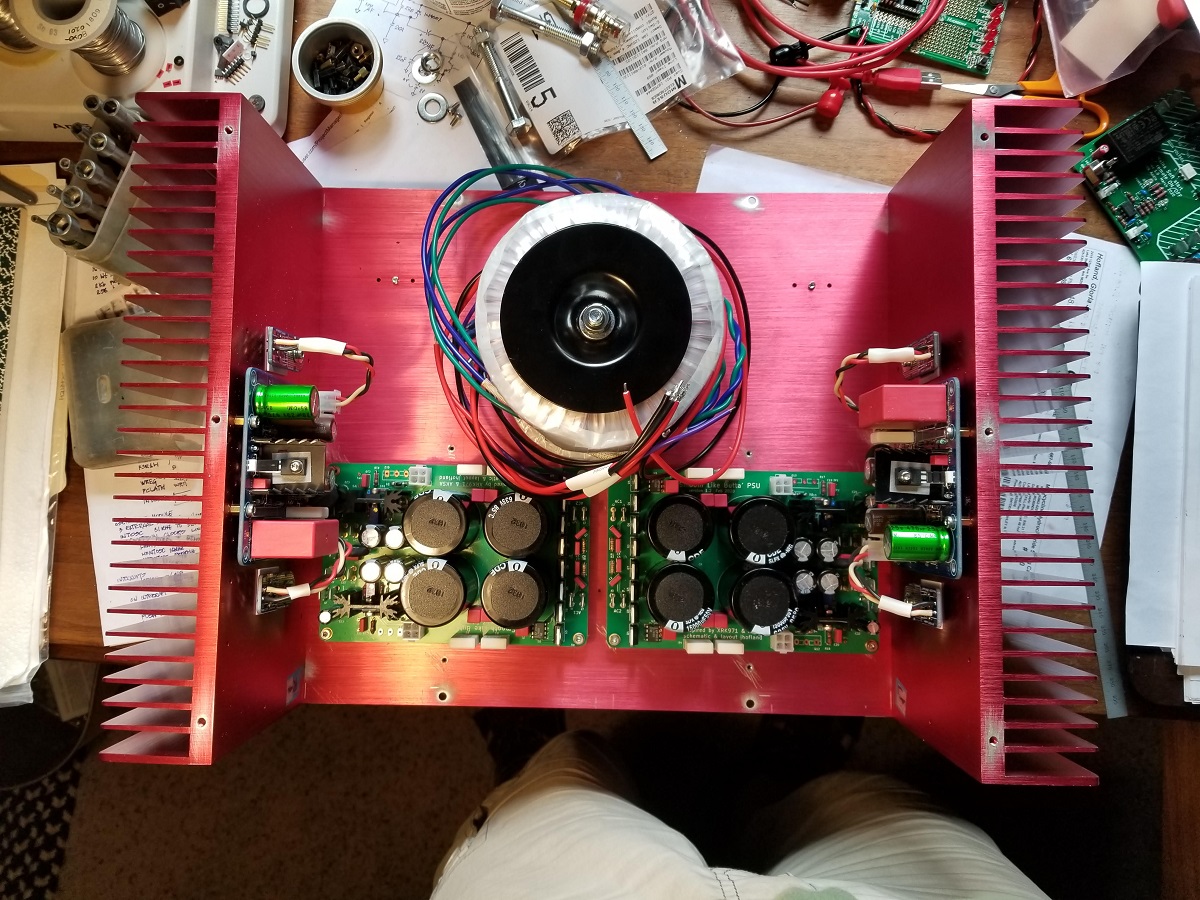
Attachments
I am posting the progress that jhofland is making on a commissioned amp for a member on DIYA with the usual dual SLB's and dual trafos for the PSU.

Dual traffos, X? 😕
Are they stacked?
Andy
If you look carefully, you can see two on top of each other.
So it's not a (magnetic field) problem to stack them?
Andy
I’ve done it myself. I think on crossover inductors you want them orthogonal and far apart. Power toroidals keep most of their magnetic fields compact and inside the windings, and going around in a torus, unlike a loop air core inductor which has A very wide extensive field. I think Jhofland would have avoided this if it were a problem.
So it's not a (magnetic field) problem to stack them?
Andy
I stacked mine too in my USSA5, no issues, but I choose to wire them both in the same phase @primary side.
Yes, I have been successful before doing it the same as you see here. I've stacked them so the leads for the bottom transformer are on the top and the ones for the top transformer are on the bottom. There's a small spacer roughly 3mm thick added between the two transformers so the leads don't get crushed.
I stacked mine too in my USSA5, no issues, but I choose to wire them both in the same phase @primary side.
Surely one would always do this?
Yes, I have been successful before doing it the same as you see here. I've stacked them so the leads for the bottom transformer are on the top and the ones for the top transformer are on the bottom. There's a small spacer roughly 3mm thick added between the two transformers so the leads don't get crushed.
That seems like a very logical thing to do, jh ... but does it actually deliver any better result than doing the opposite? (So the leads for the bottom transformer are on the bottom and the ones for the top transformer are on the top.)
Can anyone confirm that if you choose not to stack the power traffos but put them side by side ... then the further apart they are, the better? (To minimise magnetic field coupling.)
Andy
Hi Andy,
I started my USSA5 with the trafos stacked and Alpha Nirvana with the trafos side by side. Then decidedly to stack the AN’s trafos and change the USSA5 trafo’s to side by side orientation. I didn’t notice any changes in sound at all. I believe properly routed wiring and grounding scheme have a much bigger influence to ‘noise’.
I started my USSA5 with the trafos stacked and Alpha Nirvana with the trafos side by side. Then decidedly to stack the AN’s trafos and change the USSA5 trafo’s to side by side orientation. I didn’t notice any changes in sound at all. I believe properly routed wiring and grounding scheme have a much bigger influence to ‘noise’.
I have also stacked side by side directly adjacent with no issues. One of my quietest amps has two toroidals side by side and touching each other because case is so tight. Like I said earlier, a toroidal transformer keeps most of its magnetic flux in a right donut shaped bundle *inside* the windings. Anything outside has to make a loop perpendicular to the toroidal field and the loop must complete a circuit that encloses (go through the central donut hole) that magnetic field path. Otherwise, it’s not a huge influence.
From your line of questioning Andy, it doesn’t sound like you are going to take the explanations and anecdotal evidence by any of us. Please read up on toroidal transformer theory and see why a toroidal is used. It’s the same reason nuclear fusion reactors that use magnetic containment are in a toroid. The magnetic field is almost perfectly captured inside the tokamak.
From your line of questioning Andy, it doesn’t sound like you are going to take the explanations and anecdotal evidence by any of us. Please read up on toroidal transformer theory and see why a toroidal is used. It’s the same reason nuclear fusion reactors that use magnetic containment are in a toroid. The magnetic field is almost perfectly captured inside the tokamak.
Last edited:
I have also stacked side by side directly adjacent with no issues. One of my quietest amps has two toroidals side by side and touching each other because case is so tight. Like I said earlier, a toroidal transformer keeps most of its magnetic flux in a right donut shaped bundle *inside* the windings. Anything outside has to make a loop perpendicular to the toroidal field and the loop must complete a circuit that encloses (go through the central donut hole) that magnetic field path. Otherwise, it’s not a huge influence.
That's great to hear, X - and thank you also, V, for your descriptions of what you have done. 🙂
From your line of questioning Andy, it doesn’t sound like you are going to take the explanations and anecdotal evidence by any of us.
That's a bit unfair, X.
I have learnt something today that will help me a lot in future amp builds. I had simply always thought that traffos needed to be separated (which has problems, sometimes.
Andy
Hi Andy,
Sorry - I didn’t mean to offend you. It’s just that three of us (Jhofland, Vunce, myself) whom have built amps with toroidals stacked top/bottom or side/side mode, tell you that it’s fine, and your questions just keep coming... makes it sound like you are not satisfied with our explanations.
Sorry - I didn’t mean to offend you. It’s just that three of us (Jhofland, Vunce, myself) whom have built amps with toroidals stacked top/bottom or side/side mode, tell you that it’s fine, and your questions just keep coming... makes it sound like you are not satisfied with our explanations.
Hi Andy,
Sorry - I didn’t mean to offend you. It’s just that three of us (Jhofland, Vunce, myself) whom have built amps with toroidals stacked top/bottom or side/side mode, tell you that it’s fine, and your questions just keep coming... makes it sound like you are not satisfied with our explanations.
Maybe Im just one who needs to be told 3 times, X? 🙂
Andy
- Home
- Amplifiers
- Solid State
- Alpha Nirvana 39w 8ohm Class A Amp
